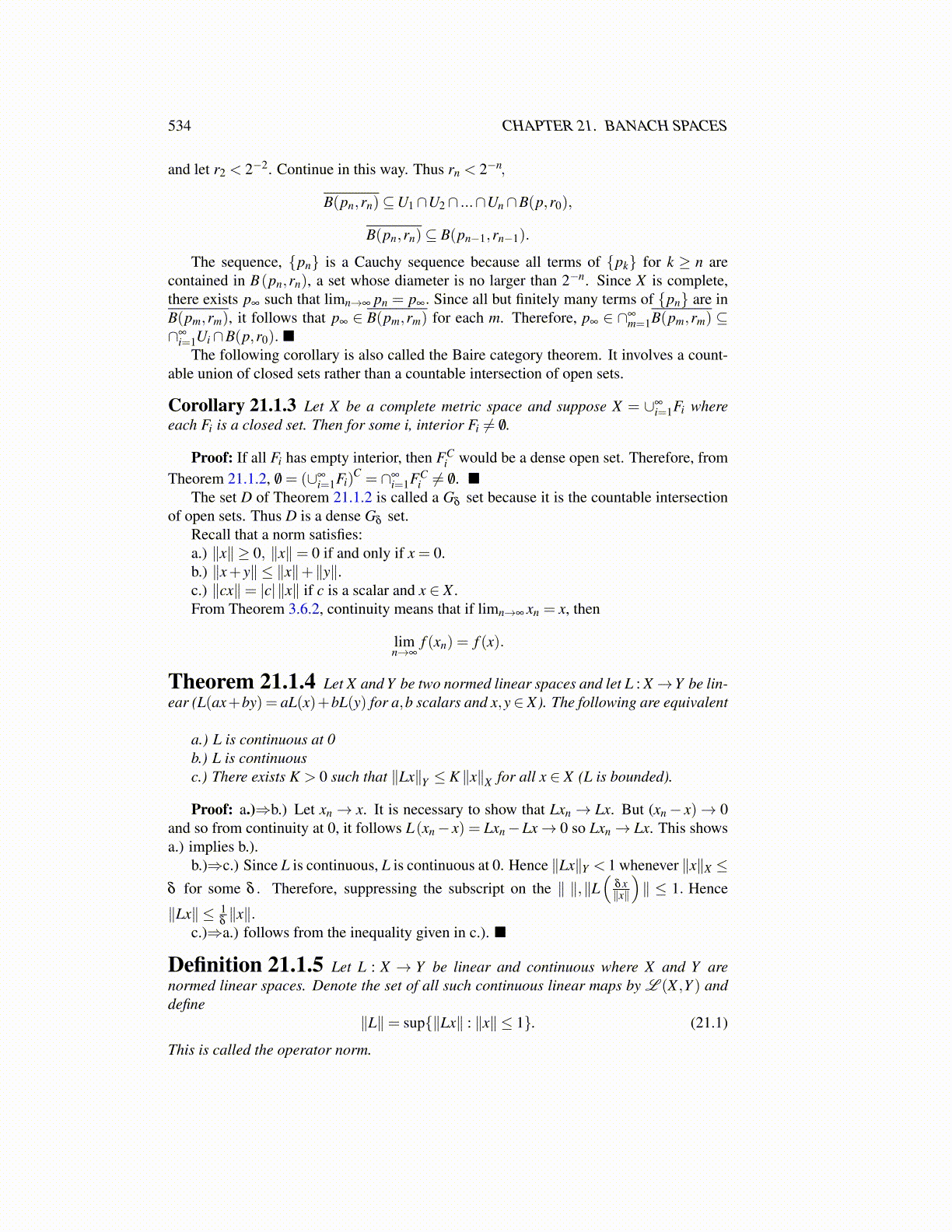
534 CHAPTER 21. BANACH SPACES
and let r2 < 2−2. Continue in this way. Thus rn < 2−n,
B(pn,rn)⊆U1∩U2∩ ...∩Un∩B(p,r0),
B(pn,rn)⊆ B(pn−1,rn−1).
The sequence, {pn} is a Cauchy sequence because all terms of {pk} for k ≥ n arecontained in B(pn,rn), a set whose diameter is no larger than 2−n. Since X is complete,there exists p∞ such that limn→∞ pn = p∞. Since all but finitely many terms of {pn} are inB(pm,rm), it follows that p∞ ∈ B(pm,rm) for each m. Therefore, p∞ ∈ ∩∞
m=1B(pm,rm) ⊆∩∞
i=1Ui∩B(p,r0). ■The following corollary is also called the Baire category theorem. It involves a count-
able union of closed sets rather than a countable intersection of open sets.
Corollary 21.1.3 Let X be a complete metric space and suppose X = ∪∞i=1Fi where
each Fi is a closed set. Then for some i, interior Fi ̸= /0.
Proof: If all Fi has empty interior, then FCi would be a dense open set. Therefore, from
Theorem 21.1.2, /0 = (∪∞i=1Fi)
C = ∩∞i=1FC
i ̸= /0. ■The set D of Theorem 21.1.2 is called a Gδ set because it is the countable intersection
of open sets. Thus D is a dense Gδ set.Recall that a norm satisfies:a.) ∥x∥ ≥ 0, ∥x∥= 0 if and only if x = 0.b.) ∥x+ y∥ ≤ ∥x∥+∥y∥.c.) ∥cx∥= |c|∥x∥ if c is a scalar and x ∈ X .From Theorem 3.6.2, continuity means that if limn→∞ xn = x, then
limn→∞
f (xn) = f (x).
Theorem 21.1.4 Let X and Y be two normed linear spaces and let L : X→Y be lin-ear (L(ax+by) = aL(x)+bL(y) for a,b scalars and x,y∈ X). The following are equivalent
a.) L is continuous at 0b.) L is continuousc.) There exists K > 0 such that ∥Lx∥Y ≤ K ∥x∥X for all x ∈ X (L is bounded).
Proof: a.)⇒b.) Let xn → x. It is necessary to show that Lxn → Lx. But (xn− x)→ 0and so from continuity at 0, it follows L(xn− x) = Lxn−Lx→ 0 so Lxn→ Lx. This showsa.) implies b.).
b.)⇒c.) Since L is continuous, L is continuous at 0. Hence ∥Lx∥Y < 1 whenever ∥x∥X ≤δ for some δ . Therefore, suppressing the subscript on the ∥ ∥,∥L
(δx∥x∥
)∥ ≤ 1. Hence
∥Lx∥ ≤ 1δ∥x∥.
c.)⇒a.) follows from the inequality given in c.). ■
Definition 21.1.5 Let L : X → Y be linear and continuous where X and Y arenormed linear spaces. Denote the set of all such continuous linear maps by L (X ,Y ) anddefine
∥L∥= sup{∥Lx∥ : ∥x∥ ≤ 1}. (21.1)
This is called the operator norm.